Chapter 39: We work with the SAS

Gee I am really enjoying being the platoon sig as I am now privy to all the things that are going on around us instead of being isolated behind the machine gun in 5 section. I think too that Killer and I have reached an understanding. He often nods to me and I think we both realise that we were a pretty good team for that 12 months.
CAPTION: The author, Ian Cavanough (right), showing Roy how to use a radio properly.
“He was always seeking my advice.”
I carry completely different stuff now. I don’t have much webbing, all I have is a web belt and only two ammo pouches on them and nothing else – I don’t need the shoulder straps. This is because I now carry an M16 and, whereas magazines are normally carried in the ammo pouches, I carry them in a sling over my shoulder. The rounds for the SLR come in slings and the rounds are stored in clips in little pouches. These pouches take an M16 magazine, so I fill them up with M16 magazines, tie a knot in the SLR ammo sling, and carry it over my shoulder.
We also have a second radio in the platoon now. When Mal, another bloody West Australian, joined us I found out that he was a fully trained sig and I was worried of course that Moon the platoon commander may want Mal as the platoon sig. This did not eventuate however and I can’t recall if there was any issue between Mal and me, certainly when we met again years later there was no issue between us. Mal was in 5 section and Moon decided that he should carry a second radio for the platoon.
This had a couple of advantages.
First, the platoon had a means of communicating when we split into half-platoon patrols.
It seems that our continual presence in the Land Clearing Teams, the Nui Dinh Mountains and the area generally west of Route 2 was so successful that the enemy engineer company headquarters moved out of the area and we were only detecting small groups now. Johnny Three Fingers our CO knows what he is doing after all. Our platoon strength is about 23 soldiers, a lot less than the 30 it should be and it was a logical step to have half platoon patrols and the extra radio allowed for efficient marryup procedures.
The other advantage of a second radio made my job easy each night. At midnight I had to change frequencies. I thought this was a bit silly because irrespective of operational conditions I had to change frequencies at midnight – not good when you are in ambush close to a track where the enemy may stroll along at any time and here I am click, click, clicking, changing frequencies and doing radio checks. I often had to use a torch because even though the radio had a light it was often difficult to read the dials. I had to be careful to conceal most of the beam in my hand. But now in full daylight I could set the second radio on the new frequency and wait for the frequency change from company HQ at midnight and then pick up the other handset for a radio check on the new frequency. Simple.
Mal carries his radio in the top of his pack, he has no need to carry all the radio CES and codes and stuff; whereas my radio is mounted on a frame. Attached to the radio is a CES pack which contains a 10 foot aerial and another component aerial I throw up into a tree for when comms were really bad. I also carry the radio codes in the CES pack. These codes give me all the radio frequencies and the days they were to be used. They are used to encode and decode messages because no vital information is ever sent in clear (plain English) over the radio. The exception is when we are in contact with the enemy, then everything is in clear. The codes for use each day I would transfer to my ammo pouches along with a notebook to record all messages I received and sent. I held onto this book for many years but somewhere along the way it went missing. I wish I still had it now because of lot of activities we did such as visiting the same places are few times over are all jumbled up in my head and I am struggling to get the proper sequence of events right.
In the lower part of the frame was a large pack that tied at the top. I used this to store my rations and sleeping gear as well as a spare battery for the radio. Water bottles were attached to the outside. In all it wasn’t too bad to lug around. The pack easily detached from the frame so I could easily release it. This happened when the platoon split into two using our current location as a base.
If a small recce party went out and wanted to travel light they would come in and get my M16 and ammo sling and leave me their SLR and ammo. If they took my radio, they just had the radio and frame, and Mal would leave his radio with me. It seemed to work out pretty well. The guys on small recce patrols could move swiftly and silently through the scrub because they were not carrying any weight.
The CO had the rifle companies rotating through the Nui Dinhs to deny the enemy access. Indeed there was very little happening. For a week or so we worked with the SAS (Special Air Service) in the Nui Dinhs. These guys are supergrunts and they go out in four-man patrols to gain intelligence on the enemy. Their uniforms are different to ours and they wear gloves with the fingers cut out. Whereas we use secateurs to trim the path through the jungle they simply push the vines and branches back slowly and silently so they leave no trace and the gloves protect their hands from thorny scrub. The patrol leader carries a combination M16/M79 weapon they called an over-and-under – I wish we had one but I don’t think Wooly would give up his M79. I’m not sure of all the weapons they carried but one of the blokes had a cut-down SLR. Maybe it was an AR – similar to the SLR but with beefier parts and it was a fully automatic weapon. His barrel was also cut down.
We moved through our AO (area of operation) in the normal way – that is we set off early, made a base a couple of hours later and sent out a couple of patrols, and then camped somewhere for the night. The SAS took some of our blokes out for each patrol and, bingo, first patrol struck the enemy. Mick the platoon sergeant took my radio and went with them, it wasn’t long before we heard automatic gunfire bursts and also a couple of M79 rounds going off. The platoon stood to and waited for instructions from the boss. I heard nothing on the radio from Mick. It is normal procedure to send a message “contact, contact” over the radio so that no one will come on air until the contact is finished, thus leaving the channel open for the group in contact to use the radio at any time. About 10 minutes later they came running back in. Mick was really excited and explained to me what happened. It seems they ran into a couple of enemy, the scout opened fire and one of the SAS guys moved forward in support and then they withdrew, popping a couple of M79 rounds up in the air as they returned back to our base. Later we cleared the area and found nothing. It just goes to show that Nigel is still about.
Mick told me in minute detail about how it feels when you are running away and there’s plenty of shooting going on. He told me how you get this giant twinge in the middle of your back. He stood there all excited and I had to ask for my radio, it was still on his back. He handed it to me, and I could see that it was covered in leaves and twigs and the handset was missing – it was torn off as he ran through the jungle. No wonder he didn’t call us, he didn’t even know the handset was missing!
We ordered a new handset to be dropped in by chopper the next day. The next day we sent out a few more patrols and then stopped at a knoll. Suddenly the sentry who was positioned a few yards down a track came running back in, his eyes seemed to cover his whole face, he said nothing, he didn’t need to.
Before I had a chance to take cover there was automatic gun fire and all hell broke loose. I grabbed the radio handset, took a deep breath and calmly spoke yelled, “One zero, one zero, this is one two, one two, contact contact, wait out!” I then buried my head deep behind the radio and the rest of my body seemed to shrink down in size behind it.
The gunfire stopped after those initial couple of bursts. No one was shooting back at us; the enemy probably took off. Moon waiting for a few minutes and then decided to head down the track to see what was going on. This could be dangerous. 1 Platoon had a contact a few days before and followed up the enemy only to be confronted with a claymore with the wiring spooled out but the firing device not attached – they were very lucky. No doubt Moon had this in mind. I saddled up and went with him and a few others down the hill. There were a couple of packs on the track and plenty of blood, but no bodies. We continued following the blood trail down. Gee this guy was losing a lot of blood; it was on the vegetation everywhere.
A hundred metres down the hill the blood trail was getting hard to follow and it was getting quite dark. Moon decided to move back up the knoll and check it out at first light next morning.
Later, in platoon headquarters, I managed to hear the story from Grant the sentry. He was sitting on the ground just off the track when he heard someone stumble. The sound was like a boot hitting a rock on the track. After he heard it a second time he moved back into the perimeter brandishing the enemy signal even though he didn’t actually see anyone – they were still in dead ground.
One of the SAS guys was sitting on some rocks off to the side, his cut down SLR was resting across his lap. When Grant came running back brandishing the enemy sign he grabbed his rifle and faced it down towards the track just as an enemy soldier came into view. The enemy stopped and stared, he seemed to be looking straight at the SAS guy who by now had his rifle pointing right at him from his waist. He stayed motionless, his finger was on the trigger but his safety catch was positioned between ‘off’ and ‘auto.’ He dared not make any sudden move so he slowly clicked the safety catch to ‘auto’. The SAS guy reckons the enemy soldier heard it, so he fired an automatic burst at him from the waist and the enemy dropped out of sight.
I don’t think many of us got much sleep that night. Our position was compromised and normally we would move to a new location, but at the moment the knoll was probably the best place to be. During the night the guys from 4 section said they could hear moaning – and it wasn’t Barry talking in his sleep.
Next morning we followed up the blood trail. It went down the hill and then across to the right and then back up the hill. We found him still alive. He had crawled back up the hill and he was not far from our night position.
“They do that just in case we called in artillery, near us is the safest place from the artillery barrage. These blokes are gutsy.”
I dunno who said that but I started to have some respect for these enemy guys. I sat there and watched doc bandage him up. He was wounded in the shoulder. This was the first live enemy I saw, and what struck me was how white the whites in his eyes were. Maybe it had something to do with his loss of blood.
Later a chopper came and Nigel was winched up and taken away. Sum Wun said that in hospital he kept pulling out the tubes they stuck in him and he died a couple of days later.
That day changed the platoon. We had been in this area a couple of times and saw no enemy, and then suddenly, working with the SAS, we had a couple of contacts. Maybe the way we operate was the problem – the enemy hears us and bugs out. From then on we started to move a lot more slowly and silently through the jungle and minimised any sound.
We have to play it smarter to catch these guys.
.
.
Reproduced with permission from FUN, FEAR, FRIVOLITY – A tale by an Aussie infantry soldier in the Vietnam War – which is now also available in ebook format. See here to order.
..
.
Hi guys. I am a good-looking, opinionated old fart who relishes a spirited debate on any topic regardless of how much I think I know about it.
Ian Cavanough,
Tumut, NSW
.
.
.
..
.
.

.
.

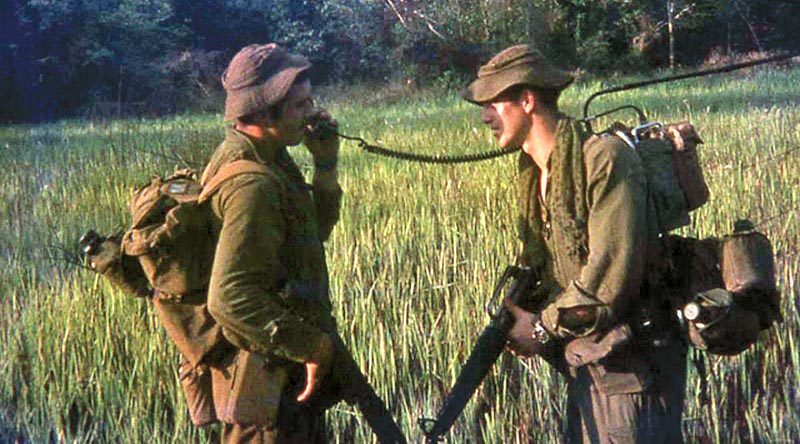

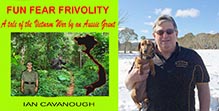
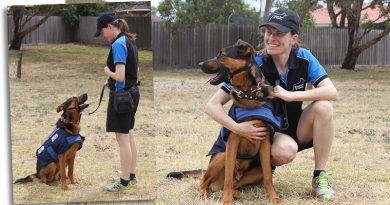
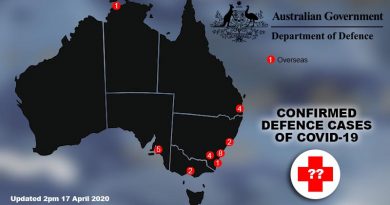
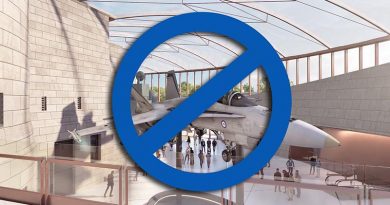
I enjoy every copy of Contact. Keep up the good work.